
Table of Contents
Overview
In the evolving landscape of AI-powered development platforms, App2.dev emerges as a specialized tool designed to convert natural language descriptions and Figma designs into functional web and mobile applications. Founded in July 2025, the platform leverages AI models from Anthropic Claude, OpenAI, and Google Gemini to generate production-ready code with integrated backend infrastructure, database configuration, and authentication systems. App2.dev targets both technical developers seeking to accelerate prototyping workflows and non-technical founders who want to build applications without extensive coding experience.
Key Features
App2.dev provides a comprehensive development platform with several core capabilities:
- Figma-to-code conversion: Analyzes Figma design files to automatically generate React Native-based mobile applications and web code, parsing design layers, navigation flows, and component structures to produce front-end scaffolding.
- Full-stack generation with backend services: Automatically provisions backend infrastructure including serverless functions, database schema, authentication flows, and storage systems, eliminating manual backend configuration.
- Multiple AI model integration: Leverages Claude, ChatGPT, and Gemini for code generation, with plans to support model selection and bring-your-own-keys functionality on higher subscription tiers for enhanced customization.
- Real-time sandbox preview: Provides secure development environments where users can preview applications instantly, iterate quickly, and test changes before deployment.
- One-click deployment integration: Connects with GitHub for version control and Vercel for hosting, streamlining the deployment pipeline from development to production.
- Team collaboration features: Supports workspace functionality for up to 5 team members with plans to scale to 50, including project sharing, credit pooling, role-based access controls, and collaborative development capabilities.
How It Works
App2.dev operates through a streamlined development workflow designed for rapid application generation. Users begin by either uploading Figma design files or describing their application concept in natural language through the platform’s prompt interface. The platform’s AI analyzes the input, automatically detecting screen flows, user journeys, and navigation patterns from Figma designs or interpreting functional requirements from text descriptions. The system then generates both front-end code, typically using React Native for cross-platform compatibility and back-end infrastructure including API endpoints, database schemas, authentication mechanisms, and serverless functions. Throughout development, users can preview applications in real-time within secure sandbox environments, make iterative refinements through additional prompts, and deploy final applications directly to GitHub repositories and Vercel hosting with a single click. The platform maintains project organization through grouped contexts, preventing the fragmentation common in prompt-based development tools.
Use Cases
App2.dev addresses various development scenarios across different user profiles:
- Rapid MVP development for startups: Enables founders to build and launch Minimum Viable Products quickly to validate market demand, secure early user feedback, and demonstrate concepts to potential investors without extensive development timelines or budgets.
- Design-to-production automation: Streamlines the traditionally labor-intensive process of converting design mockups into functional code, significantly reducing front-end development cycles and bridging the designer-developer handoff gap.
- Application prototyping: Facilitates creation of interactive, functional prototypes for stakeholder demonstrations, user testing sessions, and iterative design refinement before committing resources to full-scale development.
- No-code app creation for non-technical users: Empowers designers, product managers, and entrepreneurs without programming backgrounds to build and deploy functional applications, democratizing access to app development.
- Accelerated development for technical teams: Provides developers with automated scaffolding for repetitive setup tasks, allowing them to focus on complex business logic and custom features rather than boilerplate code generation.
Pros \& Cons
Advantages
App2.dev delivers several meaningful benefits for users seeking rapid application development:
- Significantly accelerated time-to-deployment: Reduces development cycles from weeks or months to days by automating front-end scaffolding, backend provisioning, and infrastructure setup.
- Native mobile app generation: Produces React Native applications that provide authentic native-feeling experiences on both iOS and Android platforms, along with web application support from a single codebase.
- Bundled full-stack infrastructure: Includes authentication, database, serverless functions, and storage solutions as integrated components, eliminating the need to separately configure and connect these services.
- Early access community support: Provides active Discord channels for user feedback, bug reporting, feature requests, and troubleshooting assistance during the platform’s ongoing development phase.
- Model flexibility roadmap: Plans to offer AI model selection and bring-your-own-API-keys functionality, giving users greater control over code generation quality, costs, and vendor dependencies.
Disadvantages
Potential limitations warrant consideration for prospective users:
- Early access stability challenges: As a platform still in its early access phase founded in July 2025, users have reported stability issues, deployment interruptions, and infrastructure outages that can impact development workflows and production readiness.
- Limited customization for complex logic: May not provide the granular control or flexibility required for highly specialized application logic, intricate business rules, or unique architectural patterns without substantial manual code editing.
- Deployment dependencies: Relies on specific platforms, GitHub and Vercel, which may not align with all organizational infrastructure preferences, existing deployment pipelines, or enterprise requirements.
- Long-term cost considerations: While the platform offers free early access tiers, production usage at scale will likely incur expenses from hosted AI model consumption, infrastructure costs, and subscription fees that should be evaluated against project budgets.
How Does It Compare?
The AI-powered app development landscape in 2025 features numerous platforms, each with distinct positioning and capabilities. Bubble remains the heavyweight for complex web applications and marketplaces, offering unrestricted visual programming with full backend control and database management, though it requires a steeper learning curve and primarily focuses on web rather than native mobile apps. Adalo specializes in simple mobile and web applications with a drag-and-drop interface focused on mobile UI, offering transparent pricing starting at \$36/month, but faces scalability limitations and higher vendor lock-in risk for growing applications. FlutterFlow targets native mobile app development with full Flutter source code export, providing strong scalability and very low vendor lock-in, positioning itself as a bridge between no-code convenience and professional mobile development. Glide excels at transforming spreadsheets into internal business tools with real-time Google Sheets and Airtable synchronization, but primarily serves simpler use cases rather than complex applications. Create.xyz focuses on developer-first code generation from natural language, producing editable full-stack scaffolding for rapid prototyping, though it lacks the polished UI output and visual builder interface of more consumer-oriented platforms. Cursor and Replit Ghostwriter provide AI-assisted coding within integrated development environments rather than complete app generation, with Cursor offering repo-wide intelligent edits in a desktop IDE while Replit Ghostwriter delivers browser-based collaborative coding with one-click deployment.
App2.dev carves its niche through its specialized focus on Figma-to-code automation combined with complete full-stack generation. While platforms like TeleportHQ also handle design-to-code conversion, they primarily export front-end code without automatically provisioning backend services, databases, and authentication systems. Builder.ai, once a prominent competitor, filed for insolvency in 2025 after burning through over \$450 million, revealing that its “AI-powered” platform relied heavily on manual development by offshore contractors rather than genuine automation. App2.dev distinguishes itself by genuinely leveraging multiple AI models for code generation, automatically analyzing Figma screen flows and navigation patterns, and bundling production-ready backend infrastructure within an integrated platform. The combination of design automation, multi-model AI integration, cross-platform native app generation, and one-click deployment positions App2.dev as a specialized solution for teams prioritizing speed-to-market with Figma-based design workflows, though users should carefully evaluate the platform’s early-access status and infrastructure dependencies against their specific requirements and risk tolerance.
Pricing and Availability
App2.dev currently offers pricing structured around early-access adoption and feature tiering. A free early-access tier provides core functionality including basic code generation, limited sandbox usage, and community support, allowing users to evaluate the platform and provide feedback during its development phase. A Pro Lifetime plan is available that unlocks advanced capabilities such as bringing your own AI model keys for cost control and model selection, finer control over code generation parameters, and enhanced feature access. The platform has not yet published detailed pricing for ongoing subscription plans, though usage-based costs for AI model consumption, hosting resources, and storage should be anticipated for production applications. Given the platform’s July 2025 founding, pricing structures remain subject to evolution as the product matures beyond early access, and prospective users should consult the official App2.dev website for current plan details and feature availability.
Final Thoughts
App2.dev represents an emerging approach to AI-assisted application development in a rapidly evolving no-code and low-code landscape. By integrating Figma design conversion with complete full-stack code generation powered by multiple leading AI models, the platform addresses a genuine workflow gap between design tools and deployment-ready applications. The automation of front-end scaffolding, backend provisioning, authentication setup, and deployment infrastructure delivers meaningful time savings for MVP development, prototyping workflows, and teams operating under time constraints. However, as a platform founded in July 2025 and currently in early access, prospective users should carefully weigh the benefits of rapid development against considerations including platform stability, limited customization for complex requirements, infrastructure dependencies on GitHub and Vercel, and evolving pricing structures. The platform appears best suited for startups and small teams prioritizing speed-to-market for Figma-based mobile applications, designers seeking to translate mockups into functional prototypes without developer dependencies, and technical teams willing to accept early-access limitations in exchange for accelerated development cycles. As the platform matures, addresses stability concerns reported by early users, and solidifies its feature set and pricing model, App2.dev has potential to become a valuable tool in the AI-assisted development ecosystem, though users requiring mission-critical stability or highly specialized customization may benefit from waiting for the platform to reach greater maturity or considering more established alternatives.

